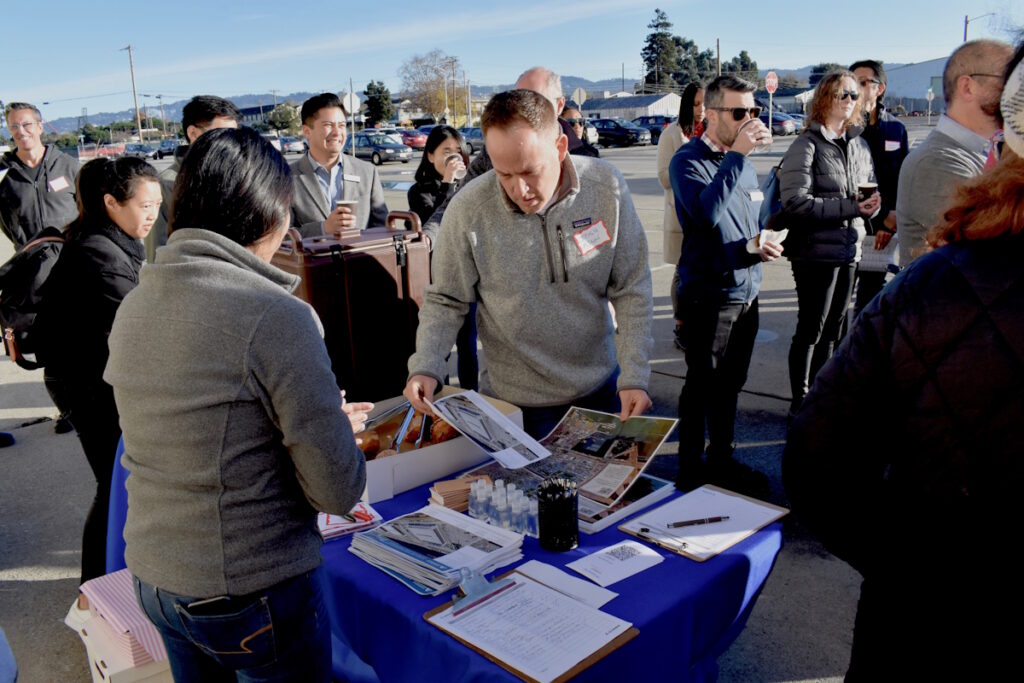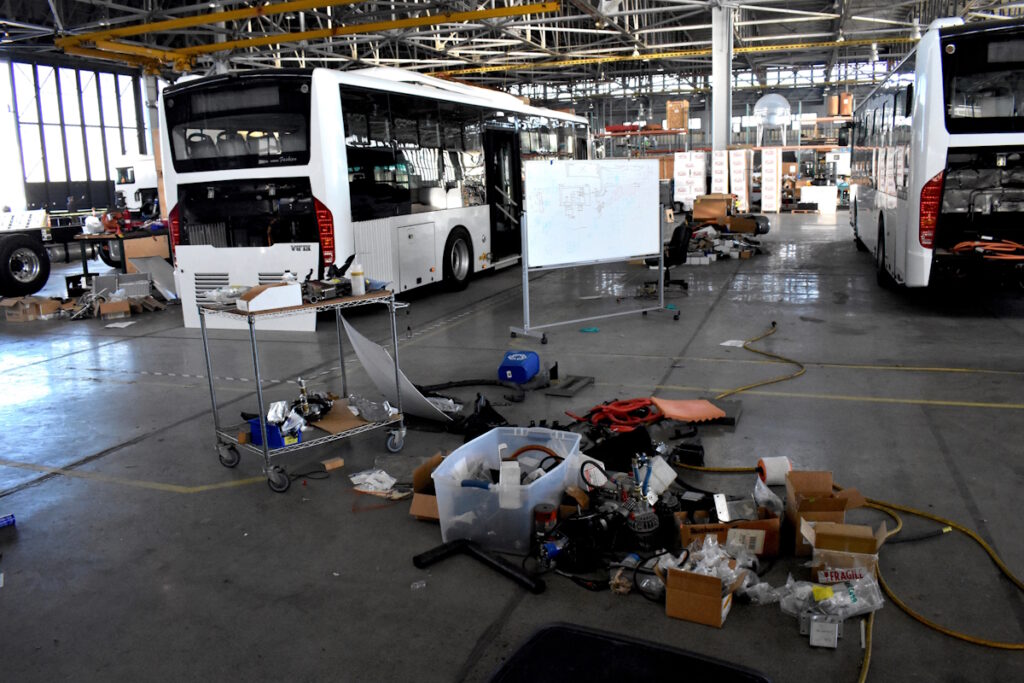Loss Of Tenants As Rockwall Winery and Wrightspeed/Revo Spurs “Use Priority” Promotional and Public Comment Event To Help Advise City Council
The City Of Alameda is more than a local city government in charge of police, fire, public works, parks, public policy and other standard functions.
It is also the biggest landlord and property owner in town, with its crown-jewel being the more than 2,600 acre former Naval Air Station.
But as any landlord knows, vacancies in lease properties cause revenue declines and The City faces several vacant warehouse properties which it is trying to market to compensate for decreased funds flowing from those properties into its coffers.
With that in mind on Friday, Dec 8th, The City held the town’s largest Open House of sorts –-more like Open Warehouse to be exact– as about eighty persons gathered to tour four vacant business zoned structures in need of enterprises wishing to lease.
Formally conducted as a special meeting of the City Council, the tour included members of the public, local interest groups, representatives from real The Real Estate Brokerage Firm, Cushman & Wakefield, the city’s designated broker, city staff, and all five City Council members.
The “Alameda Point Leasing Tour”, as it was billed, took about two and a half hours and was, as its name suggested, a combined sales pitch, an inside look at yawning expanses of space the lie behind typically closed doors, a political meeting and a local schmooze with city officials and involved community representatives as those from The Chamber Of Commerce and The Navy Base Realignment and Closure (BRAC), among others.
“Radium”, a local performing arts dedicated group, was also represented in its aspiration to find a spot where a top notch Performing Arts Center might be built , to complement their outdoor “Radium Runway” venue next to Seaplane Lagoon.
How many of the attendees were prospective lessees, and how ripe the market is for bringing in new occupants was anybody’s guess, but the tour put the market on notice and fulfilled California “Sunshine Law” requirements for an event where all City Council members were present for a policy decision making related event.

In the most clinical sense, the tour was about fulfilling development goals by gathering feedback “that will inform the sale or lease of several buildings in the Reuse Area, including Buildings 41 and 92 (future sale), as well as Buildings 24 and 11 (future lease)…. to ensure the City Council, Economic Development and Planning Development, (EDAP), the general public, and Planning Board … to view the buildings and gain a shared understanding of the local context, physical opportunities and constraints, and infrastructure and investment needs of the properties.”
Those matters were considered on Dec, 13 at The Mayor’s Economic Development Advisory Panel (EDAP) meeting.
Heading up the tour, and taking to the microphone at various stages of the event were City Manager Jennifer Ott, and Andrew Thomas, the soon to retire, long time head of Alameda’s Department of Building, Planning and Transportation, and several members of Wakefield and Cushman.
Some back history of the base entered into the narrative, but much of the focus centered on how different, vacant building spaces might serve particular industries, businesses or other tenants seeking space in buildings.
Naturally, the structural flaws of aging buildings became a topic of focus, regarding the need for roof repairs, installation of code required safety measures as fire sprinkler systems and bathrooms in one building’s case, and even the types of “green, lower cost” electrical power that can be delivered to meet particular industrial needs.
At one point Thomas remarked that buildings left vacant do little but continue to deteriorate, one driving force, other than bolstering City lease revenues, that spurred the tour.
Costs to repair and upgrade buildings to be up to code or up to snuff for a particular business use have typically fallen on the new occupant.
First on the tour list was the massive, 118,000 square foot former aircraft hangar building 41, now vacant except for the hulking remains of two white buses, once under construction, and scores of boxes with various parts spilling out on the floor and on assembly tables.
Its prior occupant, Wrightspeed industries, an electric bus building firm, later acquired by Revo Powertrains, went bankrupt and none of their contact e mails or phone numbers are working or get responses as to when they will fully vacate.
Revo still lists the site as its home address.

Some of the permissible and city declared appropriate uses for Building 41 include “Clean Tech/ Green Tech/ High Tech; Life Sciences (without animal testing); non water access Maritime Tech; Food or Beverage Manufacturing and Multi-tenant, Small Manufacturers, artists, makers, small business, and/or office.
Off limits to new tenants are Cannabis related uses, construction yard and trucking transport operations due to traffic impacts. The City has foreclosed on rezoning to make available any of the buildings, for residential use.
The Council will, in its Dec. 19th meeting, consider whether or not to codify by City Ordinance its current restriction against leasing to companies that employ live animals in their “Life Science Research.”
By a three to one margin, with one abstention, the Council voted to deny Science Corp a base lease request to expand their facility from its current spot at Marina Village. The company says that it seeks to create a brain-machine interface to help combat blindness and other neurological disease as ALS, spinal cord injuries and more.
Citing animal research ethics concerns and a past history of alleged animal mistreatment by a company founder, Council members Vella, Daysog and Spencer voted to deny the lease, Mayor Ashcraft expressed support and member Jensen abstained.
The event capped off with a question and answer period from those still attending.
Some questions involved whether or not the City would consider “Pop Up” type, short term event uses, or whether some of the structures as Building 11 could be reconfigured to create multiple smaller spaces for varied use.
The answer to the first, from City Manager Ott and Planning, Building and Transportation spokesperson Thomas seemed to indicate “yes,” but advance notice time constraints become a limiting factor as an entertainment entity might ask fifteen months in advance to secure a booking, but City Staff cannot commit to any specific use beyond a 12 month period.
A longer timeline would require a vote of the Council, but the City might not want to foreclose on a tenant taking on a lease in excess of that time period in order to gain a short term “Pop Up” use.
The idea of constructing piecemeal, smaller use spaces within a wide open, high ceiling structure as Building 41 or 1 in order to accommodate multiple commercial uses and tenants did not seem to get much traction. The cost and time to do so, much less arranging enough willing lessees in advance would not be pragmatic or revenue optimal, said Ott.
Another question, asked earlier in the session from a member affiliated with Radium, inquired as to whether or not the City would back the construction or creation of a new Performing Arts Center in the area.
The City’s formal answer to the question –which would have to come from the Council– remains to be told, but Mayor Ashcraft made a comment that seemed to suggest that the matter deserved future consideration in some capacity.
The Council, in its next formal meeting on Dec. 19th will take up the question during its Regular Agenda, public comment session. The dialogue will consider adoption of a twelve month Exclusive Negotiating Agreement with Radium, aka Little Opera House Inc. to develop a permanent Performing Arts Center (PAC) on just over two acres of un-built base land on Pan Am Way.

The Council will also discuss and take public comment on whether or not to approve an ordinance granting a 12 month temporary use license to allow continuance of Performing Arts and Special Events at Radium Runway.
Funding for a PAC –how much and from what source or sources– would, of course, be a major factor for any such project to move ahead.
By design, the well-orchestrated meeting –replete with morning coffee and donuts, laminated maps, and a sleek, black tour bus to shuttle folks between locations– was open to the public for informational purposes and publically noticed in compliance with The City’s Sunshine Ordinance.
The meeting expressly precluded any formal Council action at the time and was not subject to the recording of minutes by The City Clerk.
A 12/13/2023 official city document from Abigail Thorne-Lyman, Director of Base Reuse and Economic Development to The Mayor’s Economic Development Advisory Panel/Economic Recovery Task Force, shows that financial elements are at the top of City Staff’s formal recommendations.
Lease and rental funding is used to help fund or defray costs of infrastructure improvements, maintenance and continued offerings for parks, bike paths and the like.
EDAP was asked to prioritize the “highest financial offer, ”seek the“ greatest capital improvements to building” by a new tenant and pick those that have a track record of “stability based on business longevity, access to capital, other measures of financial strength”
Multiple businesses currently located at the base, as well as those who have left, have shouldered the costs of structural and esthetic renovations and improvements to the property as well as bearing the costs related to maintenance of the property as in the case of a roof leak or other structural problems. They may also incur property tax burdens, and other costs as sharing a percentage of sublease revenues with The City if such a use is approved.

DEEPER, MORE DETAILED STORIES TO FOLLOW
